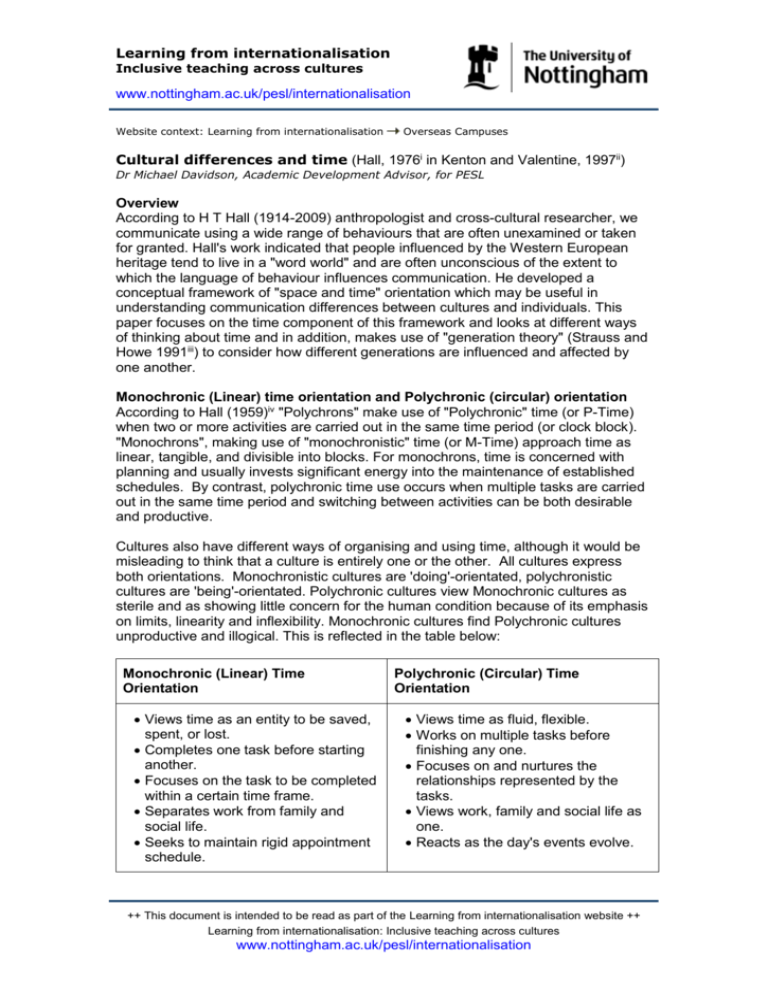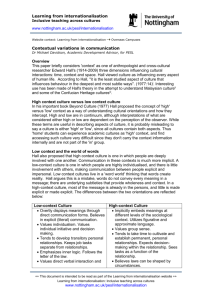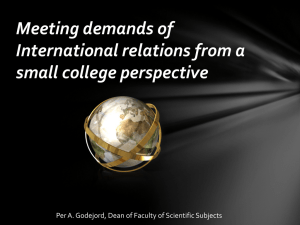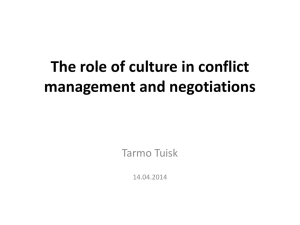Reasonable Adjustments: Overview
advertisement

Learning from internationalisation Inclusive teaching across cultures www.nottingham.ac.uk/pesl/internationalisation Website context: Learning from internationalisation Overseas Campuses Cultural differences and time (Hall, 1976i in Kenton and Valentine, 1997ii) Dr Michael Davidson, Academic Development Advisor, for PESL Overview According to H T Hall (1914-2009) anthropologist and cross-cultural researcher, we communicate using a wide range of behaviours that are often unexamined or taken for granted. Hall's work indicated that people influenced by the Western European heritage tend to live in a "word world" and are often unconscious of the extent to which the language of behaviour influences communication. He developed a conceptual framework of "space and time" orientation which may be useful in understanding communication differences between cultures and individuals. This paper focuses on the time component of this framework and looks at different ways of thinking about time and in addition, makes use of "generation theory" (Strauss and Howe 1991iii) to consider how different generations are influenced and affected by one another. Monochronic (Linear) time orientation and Polychronic (circular) orientation According to Hall (1959)iv "Polychrons" make use of "Polychronic" time (or P-Time) when two or more activities are carried out in the same time period (or clock block). "Monochrons", making use of "monochronistic" time (or M-Time) approach time as linear, tangible, and divisible into blocks. For monochrons, time is concerned with planning and usually invests significant energy into the maintenance of established schedules. By contrast, polychronic time use occurs when multiple tasks are carried out in the same time period and switching between activities can be both desirable and productive. Cultures also have different ways of organising and using time, although it would be misleading to think that a culture is entirely one or the other. All cultures express both orientations. Monochronistic cultures are 'doing'-orientated, polychronistic cultures are 'being'-orientated. Polychronic cultures view Monochronic cultures as sterile and as showing little concern for the human condition because of its emphasis on limits, linearity and inflexibility. Monochronic cultures find Polychronic cultures unproductive and illogical. This is reflected in the table below: Monochronic (Linear) Time Orientation Views time as an entity to be saved, spent, or lost. Completes one task before starting another. Focuses on the task to be completed within a certain time frame. Separates work from family and social life. Seeks to maintain rigid appointment schedule. Polychronic (Circular) Time Orientation Views time as fluid, flexible. Works on multiple tasks before finishing any one. Focuses on and nurtures the relationships represented by the tasks. Views work, family and social life as one. Reacts as the day's events evolve. ++ This document is intended to be read as part of the Learning from internationalisation website ++ Learning from internationalisation: Inclusive teaching across cultures www.nottingham.ac.uk/pesl/internationalisation The implications of this are important for cross cultural communication. Individuals with a monochronistic orientation perceived to be cold and distant by polychrons, may become frustrated with those with a polychronistic orientation who appear to have difficulty scheduling meetings. Polychrons become equally frustrated with the monochron's apparent lack of sensitivity in having no time to exchange informalities and stories and seem over-focussed on the task in hand. IMMEDIACY and CONNECTIVITY The Millennial Generation, or Generation Y (Howe and Strauss 2000v), those born after 1980 have now reached Higher Education. They were the first generation for whom new technologies did not represent a departure from a previous way of life, and these technologies have shaped Generation Y with respect to how they interact with other people and with information. This is the 'connected' generation, always in contact with one another and the world around them, which in turn has led to an unprecedented 'capacity for the instantaneous' (Nimon:2vi). The mobile is more that a phone: it is a device through which they "flirt, work, socialise and express their personality" (Huntley 2006vii). Such connectivity is leading to a number of key characteristics of the Millennial Generation in terms of how they relate to society. Opportunity/reality of Y Generation world Connectivity Global village -access not only to the international but also the global Growing sense of transience Result Expects 'immediacy' Bonding with peers rather than family; tribal mentality: group takes precedence rather than the individual. Used to a world of uncertainty and impermanence. Focus on mobility: Millennials are unlikely to stay with any one employer long. Expect immediacy. According to Nimon (2005:3) the immediacy of the millennial world has a potentially significant impact on higher education institutions. Some of this is reflected in the table below: Implications of 'connectivity and immediacy' for Higher Education Presenting behaviour or situation Academics providing an email address. Offering 'timely' response. Offering 24-hour online access. Routine collection of data from students. Everyone is contactable; punctuality sometimes not valued. Internet primary source of information which is often not-, or poorly referenced. Constant emphasis on health and safety or always rescued. Praise for everything, emphasis on strong self esteem; raised in a Impact and expectations May create expectations of instantaneous responses. Misunderstanding of what 'timely' means - unreasonable expectations May be interpreted for all services. Precedent for immediate feedback. Short-term commitment rather than longterm commitment preferred. Confusion about intellectual property ownership. Decreased emphasis on risk, creativity and imagination. Little opportunity to benchmark, or measuring themselves against others; ++ This document is intended to be read as part of the Learning from internationalisation website ++ Learning from internationalisation: Inclusive teaching across cultures www.nottingham.ac.uk/pesl/internationalisation competition-free environment. Used to having input into decisions that affect them. Expectations that everything deserves to pass. Unlikely to accept academic decision on basis of 'rules' - has to see relevance. Extremely strategic - must see the point. Dr Michael Davidson November 2009 i Hall, E. T. (1976) Beyond Culture, Garden City, New York: Anchor Press/Doubleday. ii Kenton, S.B. and Valentine, D. (1997) CrossTalk: Communicating in a Multicultural Workplace. New Jersey: Prentice-Hall. iii Strauss, W. and Howe, N. (1991) Generations. New York: William Morrow Publisher. iv Hall, E.T. (1959) The Silent Language. Garden City, New York: Doubleday. v Howe, N. and Strauss, W. (2000) Millennials rising: The next generation. New York: Vintage Books. vi Nimon, S. (2005) Generation Y and Higher Education: The Other Y2K. University of South Australia. <http://www.aair.org.au/2006Papers/Nimon.pdf> Accessed: 13 October 2009. vii Huntley, R. (2006) The world according to Y: Inside the new adult generation. Crows Nest, N. Australia: Allen and Unwin. ++ This document is intended to be read as part of the Learning from internationalisation website ++ Learning from internationalisation: Inclusive teaching across cultures www.nottingham.ac.uk/pesl/internationalisation





